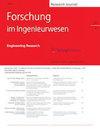Überblick über verschiedene Berechnungsansätze für die mittlere Verzahnungsreibungszahl nach ISO 6336
IF 1
4区 工程技术
Q2 Engineering
Forschung Im Ingenieurwesen-Engineering Research
Pub Date : 2023-10-04
DOI:10.1007/s10010-023-00718-y
引用次数: 1
Abstract
Abstract Important goals in gear design are high load carrying capacity, good noise, vibration, and harshness (NVH) performance and high efficiency. Regarding the load carrying capacity, the international series of standards ISO 6336 [13–15] is the state of the art for its calculation. To ensure reliable calculation of the load carrying capacity of gears and the temperatures occurring during operation, knowledge of the friction in the gear mesh is crucial. Currently, various approaches exist in the literature for calculating the mean coefficient of friction, which weight the influencing variables to varying degrees. In this publication, the empirical approaches for calculating the mean coefficient of friction given in the international series of standards ISO 6336 [13–15] are to be analyzed in terms of their origin and validated ranges, systematically compared, and contrasted. These calculation approaches are mainly covered in the parts ISO/TS 6336-20 [14], ISO/TS 6336-21 [15], and ISO/TS 6336-22 [13], which address the calculation of the scuffing load carrying capacity according to the flash and integral temperature method and the calculation of the micropitting load carrying capacity, respectively. Additionally, ISO/TR 14179‑2 [12] which describes a calculation approach for the thermal load carrying capacity will be included in this review. Besides the analysis of their origin, exemplary comparative calculations for various applications are intended to show possible differences between the various calculation approaches and enable a quantitative evaluation. The overall, long-term goal is to merge and standardize the various calculation approaches for the mean coefficient of friction in the international series of standards ISO 6336.1831年的中尉
摘要齿轮设计的重要目标是承载能力高、噪声、振动和粗糙度(NVH)性能好、效率高。对于承载能力的计算,国际系列标准ISO 6336[13-15]是目前最先进的。为了确保齿轮的承载能力和运行过程中发生的温度的可靠计算,齿轮啮合摩擦的知识是至关重要的。目前,文献中存在各种计算平均摩擦系数的方法,这些方法对影响变量的权重不同程度。在本出版物中,计算国际系列标准ISO 6336[13-15]中给出的平均摩擦系数的经验方法将根据其来源和有效范围进行分析,并进行系统比较和对比。这些计算方法主要包含在ISO/TS 6336-20[14]、ISO/TS 6336-21[15]和ISO/TS 6336-22[13]三个部分中,分别解决了采用闪蒸积分温度法计算磨损承载能力和计算微点蚀承载能力的问题。此外,ISO/TR 14179‑2[12]描述了热负荷承载能力的计算方法,将包括在本次审查中。除了分析其来源外,还对各种应用进行示例性比较计算,以显示各种计算方法之间可能存在的差异,并进行定量评价。总体而言,长期目标是合并和标准化国际系列标准ISO 6336中平均摩擦系数的各种计算方法。
本文章由计算机程序翻译,如有差异,请以英文原文为准。
求助全文
约1分钟内获得全文
求助全文
来源期刊
CiteScore
2.20
自引率
9.10%
发文量
33
审稿时长
>12 weeks
期刊介绍:
This journal is aimed at those who require an interdisciplinary overview of current research in fundamental areas of engineering science as well as outstanding contributions in their own field. It intends to encourage an exchange of ideas between the areas of research and development. Submissions are subject to regular peer review by independent experts. Mainly contributions in German from all disciplines of engineering and technology will be considered for evaluation and publication.

 求助内容:
求助内容: 应助结果提醒方式:
应助结果提醒方式:


